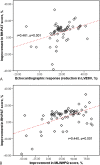Fingertip Reactive Hyperemia Peripheral Arterial Tonometry Score Predicts Response to Biventricular Pacing
- PMID: 30449989
- PMCID: PMC6236571
- DOI: 10.6515/ACS.201811_34(6).20180518A
Fingertip Reactive Hyperemia Peripheral Arterial Tonometry Score Predicts Response to Biventricular Pacing
Abstract
Purpose: The objectives of this study were to: (i) evaluate endothelial function via fingertip reactive hyperemia peripheral arterial tonometry (RH-PAT) among heart failure (HF) patients receiving cardiac resynchronization therapy (CRT), (ii) assess the effects of CRT on RH-PAT score, and (iii) investigate whether RH-PAT score can identify CRT response.
Methods: A total of 63 patients (61.8 ± 10.3 years; 50 males; left ventricular (LV) ejection fraction 24.3 ± 3.9%) with HF who received CRT were enrolled. Endothelial function via RH-PAT was assessed 1 day before and 6 months after CRT. Minnesota Living with Heart Failure Questionnaire (MLWHFQ) was used to assess clinical improvements. CRT response was defined as a reduction in LV end-systolic volume ≥ 15% at 6 months.
Results: A RH-PAT score of < 1.7 signified a cut-off for endothelial dysfunction (ED). Baseline ED was observed among 43 (68.3%) patients and was more prevalent in responders (76.1% vs. 47.1%, p = 0.037). RH-PAT score improved 6 months after CRT (1.58 ± 0.35 vs. 1.71 ± 0.31, p = 0.012). A RH-PAT score of < 1.7 was a significant independent predictor of CRT response in multivariate logistic regression analysis (β = 1.275, OR = 3.512, 95% CI = 1.231-11.477, p = 0.032). The severity of ED was an independent predictor of LV reverse remodeling (β = -8.873, p = 0.015). Spearman's correlation analysis revealed moderate positive correlations between an improvement in RH-PAT (ΔRH-PAT) and LV reverse remodeling (r = 0.461, p = 0.001) and MLWHFQ score (r = 0.440, p = 0.001).
Conclusions: ED detected via RH-PAT could predict the response to CRT. The RH-PAT score increased 6 months after CRT and was correlated with echocardiographic and clinical improvements.
Keywords: Cardiac resynchronization therapy; Endothelial dysfunction; Heart failure; Peripheral arterial tonometry; Response.
Figures



Similar articles
-
Noninvasive Investigation of the Presence and Extent of Coronary Artery Disease by the Evaluation of Fingertip-Reactive Hyperemia.Med Princ Pract. 2022;31(3):262-268. doi: 10.1159/000522098. Epub 2022 Jan 20. Med Princ Pract. 2022. PMID: 35051935 Free PMC article.
-
Improvement effect on endothelial function in patients with congestive heart failure treated with cardiac resynchronization therapy.J Cardiol. 2011 Jul;58(1):69-73. doi: 10.1016/j.jjcc.2011.01.010. Epub 2011 Apr 13. J Cardiol. 2011. PMID: 21493043
-
Multipoint left ventricular pacing with large anatomical separation improves reverse remodeling and response to cardiac resynchronization therapy in responders and non-responders to conventional biventricular pacing.Clin Res Cardiol. 2020 Feb;109(2):183-193. doi: 10.1007/s00392-019-01499-7. Epub 2019 May 31. Clin Res Cardiol. 2020. PMID: 31152199
-
Randomized trial of cardiac resynchronization in mildly symptomatic heart failure patients and in asymptomatic patients with left ventricular dysfunction and previous heart failure symptoms.J Am Coll Cardiol. 2008 Dec 2;52(23):1834-1843. doi: 10.1016/j.jacc.2008.08.027. Epub 2008 Nov 7. J Am Coll Cardiol. 2008. PMID: 19038680 Clinical Trial.
-
Endothelial Function Predicts New Hospitalization due to Heart Failure Following Cardiac Resynchronization Therapy.Pacing Clin Electrophysiol. 2015 Nov;38(11):1260-6. doi: 10.1111/pace.12698. Epub 2015 Sep 10. Pacing Clin Electrophysiol. 2015. PMID: 26227741
Cited by
-
From Real-World Evidence to Consensus of Renal Denervation in Taiwan: A Call for the Incorporation of Ambulatory Blood Pressure Monitoring after Witnessed Intake of Medications.Acta Cardiol Sin. 2019 Nov;35(6):553-556. doi: 10.6515/ACS.201911_35(6).20191103A. Acta Cardiol Sin. 2019. PMID: 31879505 Free PMC article. No abstract available.
-
Noninvasive Investigation of the Presence and Extent of Coronary Artery Disease by the Evaluation of Fingertip-Reactive Hyperemia.Med Princ Pract. 2022;31(3):262-268. doi: 10.1159/000522098. Epub 2022 Jan 20. Med Princ Pract. 2022. PMID: 35051935 Free PMC article.
References
-
- Deanfield J, Donald A, Ferri C, et al. Endothelial function and dysfunction. Part I: methodological issues for assessment in the different vascular beds: a statement by the Working Group on Endothelin and Endothelial Factors of the European Society of Hypertension. J Hypertens. 2005;23:7–17. - PubMed
-
- Yeboah J, Crouse JR, Hsu FC, et al. Brachial flow-mediated dilation predicts incident cardiovascular events in older adults: the Cardiovascular Health Study. Circulation. 2007;115:2390–2397. - PubMed
-
- Akar JG, Al-Chekakie MO, Fugate T, et al. Endothelial dysfunction in heart failure identifies responders to cardiac resynchronization therapy. Heart Rhythm. 2008;5:1229–1235. - PubMed
-
- Van Wagoner DR. Is homocysteine a mediator of atrial dysfunction or just another marker of endothelial dysfunction? Europace. 2008;10:899–900. - PubMed
LinkOut - more resources
Full Text Sources
Research Materials
Miscellaneous
